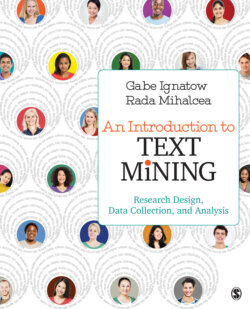Читать книгу An Introduction to Text Mining - Gabe Ignatow - Страница 68
На сайте Литреса книга снята с продажи.
Abductive Logic
ОглавлениеA weakness of both induction and deduction are that they do not provide guidance about how theories, whether grand theories, middle-range theories, or theoretical models, are discovered in the first place (Hoffman, 1999). The inferential logic that best accounts for theoretical innovation is abduction, also known, approximately, as “inference to the best explanation” (Lipton, 2003). Abduction differs from induction and deduction in that abduction involves an inference in which the conclusion is a hypothesis that can then be tested with a new or modified research design. The term was originally defined by the philosopher Peirce (1901), who claimed that for science to progress it was necessary for scientists to adopt hypotheses “as being suggested by the facts”:
Accepting the conclusion that an explanation is needed when facts contrary to what we should expect emerge, it follows that the explanation must be such a proposition as would lead to the prediction of the observed facts, either as necessary consequences or at least as very probable under the circumstances. A hypothesis, then, has to be adopted, which is likely in itself, and renders the facts likely. This step of adopting a hypothesis as being suggested by the facts, is what I call abduction. (pp. 202–203)
Abduction “seeks no algorithm, but is a heuristic for luckily finding new things and creating insights” (Bauer, Bicquelet, & Suerdem, 2014). Abductive logic does not replace deduction and induction but bridges them iteratively (through a process that repeats itself many times). It is a “forensic” form of reasoning in that it resembles the reasoning of detectives who interpret clues that permit a course of events to be reconstructed or of doctors who make inferences about the presence of illness based on patients’ symptoms.
Figure 4.3 ∎ Abductive Logic
A number of researchers who work with text mining and text analysis tools advocate for abduction as the optimal inferential logic for their research, including Bauer and colleagues (2014) and Ruiz Ruiz (2009). Bauer and colleagues (2014) argued that with abduction, text mining researchers need not do the following:
. . . face a dilemma between the Scylla of deduction on the one hand, and Charybdis of induction on the other. We suggest abductive logic as the middle way out of this forced choice: the logic of inference to the most plausible explanation of the given evidence, considering less plausible alternatives. As it entails both machine inference and human intuition, it can maintain the human-machine-text trialogue.
One of the main problems of abductive inference is how to formulate an abduction. Peirce was not especially clear on this point when he referred to a “flash of understanding” or when attributing abductive capacity to an adaptive human need to explain surprising or unexpected facts. Although Peirce did not establish formal procedures to generate abductive inferences, he did propose criteria to distinguish between good and bad abduction. These include the need for abduction to propose truly new ideas or explanations, the need to derive empirically contrastable predictions from the hypotheses, and the need for the hypotheses to fit in with or give an adequate account of the social and historical context in which they emerge (Peirce, 1901).
The sheer complexity of language as compared with the kinds of phenomena studied in the natural and physical sciences makes it difficult to implement text mining research designs that are entirely inductive or deductive. Even the most carefully planned text mining projects that are presented as though they were products of pure deductive reasoning generally result from long periods in which research teams use abductive logic to refine and reformulate their hypotheses and, at times, even their research questions.
Abductive inferential logic is compatible with the use of any number of sophisticated research tools and is used in the early stages of many deductive research designs. One example is Ruiz Ruiz’s (2009) text analysis of transcriptions of discussions with Spanish manual workers. In the transcripts, the workers are seen as criticizing the chauvinism and submissiveness of Moorish immigrants from Morocco. Ruiz Ruiz described his use of abductive, as well as inductive and deductive, logics of inference in his 2009 survey of discourse analysis methods.
Conclusion
In this chapter, we have reviewed the most critical philosophy of social science concepts that are relevant to the practice of text mining. We hope to have convinced you that philosophical assumptions and decisions about methodology are interdependent and to have given you the tools to allow you to position your own research project in terms of debates over positivist and postpositivist social science. You should also now be well equipped to recognize the types of logical inferences that are possible in different approaches to text mining and text analysis research.
